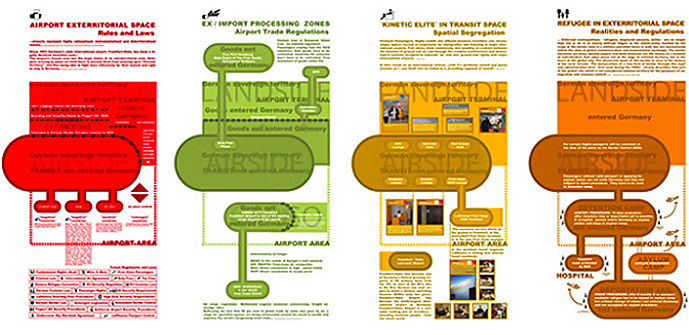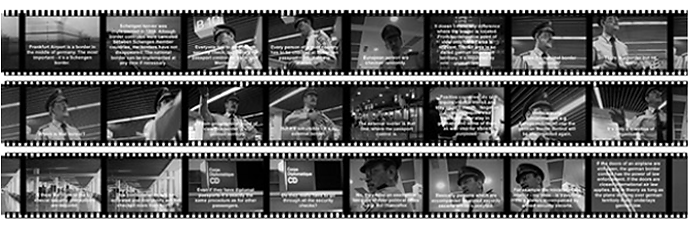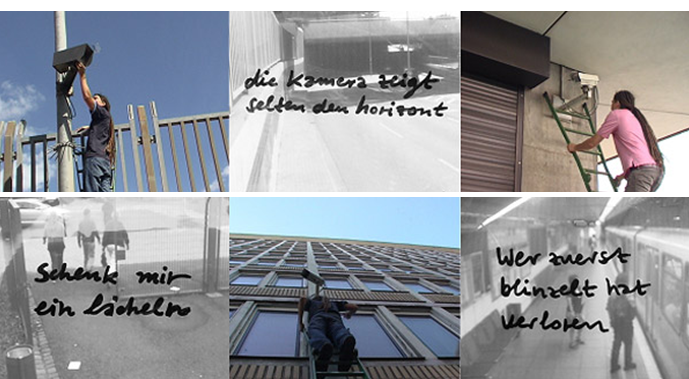
Little Sisters.
Exhibition on Visual Surveillance.
Monika Codourey : Raul Gschrey : Manu Luksch : Sandip Shah
Exhibition on Visual Surveillance.
Monika Codourey : Raul Gschrey : Manu Luksch : Sandip Shah
As part of the conference, Frankfurt-based artist and curator Raul Gschrey has compiled an exhibition of artworks by Monika Codourey (Switzerland/GB), Manu Luksch (Austria/GB) and Sandip Shah (Germany), as well as a selection of his own works on visual surveillance. The performances, interventions, videos and paintings focus on techniques of surveillance and control. Mappings and interventions critically address relationships of observation and undermine their inherent power structures. Performances encourage viewers to become active – to interact with and subvert the instruments of control. Paintings based on satellite observation challenge our perception of the ephemeral nature of the digital image. Artistic research and mappings visualise mobile borders and mechanisms of surveillance and control at the airport.
Monika Codourey
Monika Codourey is an architect and Ph.D. researcher at the universities of Plymouth, Great Britain, and Zurich, Switzerland. Her transdisciplinary projects combine her interests in architecture, urbanity and the creative and critical use of information and communication technologies for social/urban design. In her recent works she focuses on relations between changing spacio-temporal structures of contemporary city and electronic networks. She understands and investigates these relations as hybrid actions, interventions and possible places for the socio-cultural production of the information society. In particular, she investigates transformation of socio-spatial mobilities in transit spaces. www.monika.codourey.info
Monika Codourey is an architect and Ph.D. researcher at the universities of Plymouth, Great Britain, and Zurich, Switzerland. Her transdisciplinary projects combine her interests in architecture, urbanity and the creative and critical use of information and communication technologies for social/urban design. In her recent works she focuses on relations between changing spacio-temporal structures of contemporary city and electronic networks. She understands and investigates these relations as hybrid actions, interventions and possible places for the socio-cultural production of the information society. In particular, she investigates transformation of socio-spatial mobilities in transit spaces. www.monika.codourey.info
“Mapping Socio-Spatial Mobilities”
 ”In times of constant mobility, urban metropoles are turning into intersections of transit and migration of goods, capital, services, cultures, knowledge and especially people. New concepts of urbanity with a transnational range are emerging. […] International airports are examples of these emerging transnational spaces and can be understood as compressors of space and time, conduits between physical locations in the world. At the same time the extraterritorial zones of airports become an important threshold controlling the flow of people in a free market economy. It is impossible to mark the border [...]. The border mutates into an abstract space extending beyond the physical territory of the airport. Nowadays, rather than a geographical boundary of the state, airport borders are a transit condition of the mobile body. In the project Codourey has investigated at Frankfurt/Main airport. […]
”In times of constant mobility, urban metropoles are turning into intersections of transit and migration of goods, capital, services, cultures, knowledge and especially people. New concepts of urbanity with a transnational range are emerging. […] International airports are examples of these emerging transnational spaces and can be understood as compressors of space and time, conduits between physical locations in the world. At the same time the extraterritorial zones of airports become an important threshold controlling the flow of people in a free market economy. It is impossible to mark the border [...]. The border mutates into an abstract space extending beyond the physical territory of the airport. Nowadays, rather than a geographical boundary of the state, airport borders are a transit condition of the mobile body. In the project Codourey has investigated at Frankfurt/Main airport. […]
Video documenting field research, spatial analysis and mapping, 2005-06.
 ”In times of constant mobility, urban metropoles are turning into intersections of transit and migration of goods, capital, services, cultures, knowledge and especially people. New concepts of urbanity with a transnational range are emerging. […] International airports are examples of these emerging transnational spaces and can be understood as compressors of space and time, conduits between physical locations in the world. At the same time the extraterritorial zones of airports become an important threshold controlling the flow of people in a free market economy. It is impossible to mark the border [...]. The border mutates into an abstract space extending beyond the physical territory of the airport. Nowadays, rather than a geographical boundary of the state, airport borders are a transit condition of the mobile body. In the project Codourey has investigated at Frankfurt/Main airport. […]
”In times of constant mobility, urban metropoles are turning into intersections of transit and migration of goods, capital, services, cultures, knowledge and especially people. New concepts of urbanity with a transnational range are emerging. […] International airports are examples of these emerging transnational spaces and can be understood as compressors of space and time, conduits between physical locations in the world. At the same time the extraterritorial zones of airports become an important threshold controlling the flow of people in a free market economy. It is impossible to mark the border [...]. The border mutates into an abstract space extending beyond the physical territory of the airport. Nowadays, rather than a geographical boundary of the state, airport borders are a transit condition of the mobile body. In the project Codourey has investigated at Frankfurt/Main airport. […]

Raul Gschrey
As artist, curator and academic, Raul Gschrey looks into socially and politically relevant topics in a multifaceted way. He is also working in the educational field, at universities in Frankfurt/Main and the youth-media-centre “Gallus Zentrum” among others. His projects are developed with different partners, e.g. the artist collective “spez.Lab”, “wb-jung – deutscher werkbund” and other institutions. In the past years, he has been examining the phenomenon of visual surveillance and exploring artistic subversion. His recent project “grenzlinien / borderlines” expands this focus on border-crossing and irregular migration in a European context. His works reach out beyond the gallery or the museum into public space. In his work, the artist is understood as social actor who is challenged to use his special means to contribute to political and social debate. www.gschrey.org & www.pro-these.com/cctv
„Trophäen” / “trophies”

Surveillance cameras, trophy-boards, 2008 & ongoing.
Surveillance cameras originally installed in public are fixed on wooden trophy-boards usually used to display hunting successes. The used look of the cameras initiates mental images of the stories of their usage and the scenes that the camera might have kept an eye on during the time of its operation. The surveillance camera that was once used as an instrument of control and was itself “looking” at people has lost its function and is displayed in the fashion of a trophy – the power regimes of the gaze between observer and observed are subverted.

„Bewegunsspielraum“ / “space constraint“

3-channel video installation, colour, sound, ca. 3’30, 2008.
The performances constitute an attempt to direct interaction with institutions via their surveillance cameras. A person steps in front of a camera and starts to wrap himself from head to toe with black and yellow adhesive tape until his movements become restricted. Then the person looks into the lens of the camera and waits for a reaction. For the performances public spaces in Frankfurt where a reaction was likely were chosen: a subway station, the police headquarters and the Central Station. Documentation: Agustina Rodriguez, Bernd Metz.

„Die Kamera zeigt selten den Horizont” / “the camera rarely shows the horizon”

Video, colour, b/w, sound, ca. 3’, 2009.
Messages, handwritten on translucent foil, are fixed in front of the lenses of CCTV cameras operating in the city of Frankfurt. The words and sentences comment on the mechanisms of surveillance and enter into a direct conversation with potential observers on the other side of the “closed circuit”.

„Der typische Einwohner“ oder “Automatisierte Erkennung erfordert individuelle Charakteristika – sei durchschnittlich.” / “The Typical Inhabitant” or “Automated Recognition Relies on Individual Characteristics – Try to Look Average.”

Composite photographs and composite masks, 2008 & ongoing.
The series of “The Typical Inhabitants“ are composite photographs produced from portraits of men and women that move regularly in the different cities. The masks that were manufactured from the local composites can be worn in public space to prevent successful biometric recognition. The number of automated face recognition systems has increased internationally and become a threat to individual privacy. Face recognition systems use characteristics that differ from the norm to match individuals with their biometric image. In contrast, the composite technique emphasises the similarities and average characteristics that predominate in these superimpositions. For the exhibition, a composite mask of the “typical Mainzer“ was produced.

Manu Luksch
Manu Luksch, founder of London-based arts studio “Ambient Information Systems”, is working as a filmmaker in London. Through her films, telematic performances and interdisciplinary works, Manu Luksch explores her preoccupation with the effects of emerging technologies on social relations and urban and political structures. Her works focus on the structure of the urban fabric, the borders of public space, surveillance and the gaze and security and identity systems. Her recent film “Faceless”, entirely compiled from material recorded by surveillance cameras, received wide attention in the arts and academia. www.ambientTV.NET & www.function-creep.com
“Mapping CCTV around Whitehall”

Video, colour, sound, 3’, 2008.
The video is a two-part mapping project of CCTV cameras around Whitehall, London, within a zone covered by SOCPA (Serious and Organized Crime and Police Act) of 2005. A map of the hundreds of cameras in the zone was made in a two-day observation period. In the second part of the video the artist interferes with the instruments of control. She is mapping the range of one of the cameras, no. 40 in Villiers Street, by intercepting its signal, which is transmitted wirelessly without encryption. When passers-by enter the marked area covered by the camera, they are warned and receive a copy of the map of CCTV cameras in Whitehall.

“Sympathetic Nervous System”

Video, colour, sound, 12’, 2001/2011.
The video shows the faces of several of the hundred of the police officers who “kettled” protesters, bystanders and the filmmaker for seven hours during May Day demonstrations in London, 2001. Other instances of kettling have been ruled illegal. After ten years, the incident is being challenged at the European Court of Human Rights and the artist goes back to her material to present us with an intimate study of the facial expressions of the officers.

Sandip Shah
Sandip Shah lives and works in Frankfurt/Main, Germany and runs the “CWO – City Watch Office” in the studio- and exhibition space “Atelier Frankfurt”. Shah studied at the art academy in Offenbach/Main and the Städelschule in Frankfurt/Main with Hermann Nitsch and others. The topic of surveillance not only plays a major role in his (video-) installations and claustrophobic spaces of surveillance. In his paintings he also deals with the diffuse ephemeral nature of the digital (surveillance) image. www.bewohnte-kunst-installation.de
“Aerial Paintings”

Oil on canvas, varying sizes, 2008-2011.
The three works – two individual paintings and an installation combining painting and video – were modelled after aerial views, taken from google maps. The combination of aerial image and map, which are means of observation and navigation, offer planability and a certain measure of control over territory. Through his pictorial interpretation, Sandip Shah questions these connotations and attributes to his selections an aesthetic value. On the other hand, the places Shah has chosen to depict are not random selections. One painting focuses on the studio in Antwerp, Belgium, where he spent time on a artist in residence programme. Another shows a highly surveilled area, a nuclear power plant in Germany.“Sandip Shah’s cities are anything but static, lithic architecture. They do not know hard outlines, appear as energetically charged formations, seem to consist of excrescences, currents, bold-coloured, organic spots […] Sandip Shah often uses videos recorded by surveillance cameras. The origin of the material provides the towns in the paintings with a multi-faceted meaning: While observation in public space serves as a means of accurate documentation […] Shah undermines this denotation. He de-clarifies the images of the omnipresent electronic eye.” (Dr. Peter Joch, translation: Raul Gschrey)
